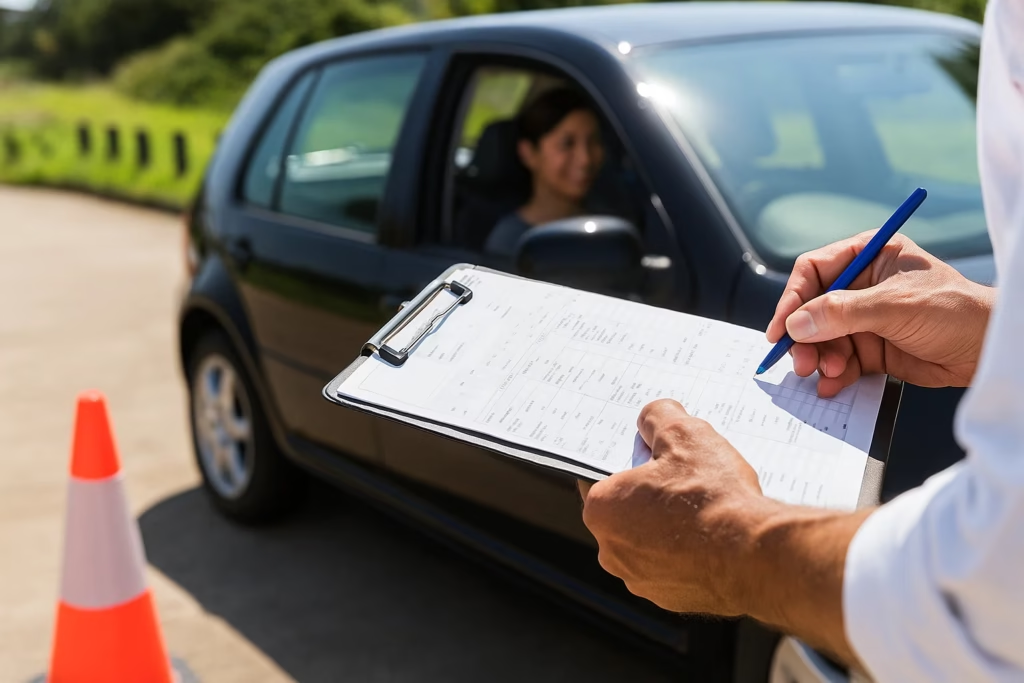Passing your driving test is a big milestone in life. It gives you freedom, independence, and the chance to finally drive on your own. But many learners fail their first attempt—not because they don’t know how to drive, but because of common driving test mistakes.
The good news? Most of these mistakes are simple to avoid once you know what they are. In this guide, we’ll cover the top 10 driving test mistakes that cause learners to fail and give you practical tips to avoid them. By the end, you’ll feel more confident and ready to pass your test on the first try.
1. Not Checking Mirrors Properly
One of the most common driving test mistakes is failing to use mirrors correctly. Many learners either forget to check their mirrors or do it too late. Mirrors help you stay aware of your surroundings. If you don’t check them, the examiner may think you are not safe to drive.
How to avoid it:
Always check mirrors before signaling, changing lanes, or slowing down.
Move your head slightly when checking so the examiner knows you’re looking.
Make mirror checks a habit, not just something you do on the test.
2. Not Using Signals Correctly
Another big mistake is forgetting to signal, signaling too late, or signaling in the wrong situation. Signals communicate with other drivers and pedestrians. Incorrect signals can confuse or endanger others.
How to avoid it:
Signal in advance, not at the last second.
Cancel your signal after a turn.
Remember: Mirror → Signal → Manoeuvre.
3. Poor Steering Control
Many learners struggle with steering , either oversteering, understeering, or crossing arms in a dangerous way. Poor steering control makes you look unsafe and increases accident risk. Beginner’s Guide to Steering Control
How to avoid it:
Practice smooth steering at different speeds.
Keep both hands on the wheel in the “9 and 3” position.
Don’t rush—control is more important than speed.
4. Incorrect Speed
Driving too fast or too slow is a classic driving test mistake. Examiners want to see that you can keep up with traffic but also stay safe. Driving too slowly can be as dangerous as speeding.
How to avoid it:
Always follow speed limits.
Adjust your speed for road conditions (rain, traffic, narrow roads).
Keep pace with traffic flow without rushing.
5. Not Observing at Junctions
Many learners fail because they don’t look carefully at junctions, roundabouts, or intersections. Missing a car, bike, or pedestrian can cause an accident.
How to avoid it:
Always look both ways before entering a junction.
Take your time—safety matters more than speed.
Don’t rely only on mirrors—turn your head to check blind spots.
6. Stalling the Car
For manual drivers, stalling during the test is very common, especially when starting at traffic lights or uphill. Stalling itself won’t always fail you, but if it causes danger or you panic, it will.
How to avoid it:
Practice clutch control in different situations.
Stay calm—restart smoothly if you stall.
Don’t rush starts; focus on balance between clutch and accelerator.
7. Bad Lane Discipline
Learners often drift between lanes, forget which lane to use, or cut across traffic. Bad lane discipline shows poor awareness and is dangerous on busy roads.
How to avoid it:
Know which lane you need in advance.
Use mirrors and signals when changing lanes.
Stay centered in your lane.
8. Failing to Respond to Traffic Signs
Ignoring stop signs, speed limits, or “no entry” signs is a serious driving test mistake. Traffic signs are there for safety. Missing one shows the examiner you’re not ready.
How to avoid it:
Stay alert and keep scanning the road for signs.
Practice in areas with lots of different road signs.
If unsure, slow down and think—it’s better than guessing.
9. Hesitation and Lack of Confidence
Being too hesitant can be as bad as rushing. For example, waiting too long at a clear junction. Examiners want to see safe but confident driving. Over-hesitation can frustrate other drivers and cause accidents.
How to avoid it:
Trust your judgment—if it’s safe, go.
Don’t overthink—practice builds confidence.
Remember: hesitation is better than danger, but don’t freeze.
10. Poor Parking and Manoeuvres
Many learners lose marks (or fail) on parallel parking, bay parking, or reversing around a corner. Good manoeuvres show control and awareness in tight spaces.
How to avoid it:
Practice all required manoeuvres many times.
Go slow and steady.
Use reference points (mirrors, car lines) to guide you.
By understanding these top driving test mistakes and how to avoid them, you’ll be much more prepared for test day. Drive safe, stay calm, and you’ll pass with confidence.
FAQ
The most common driving test mistakes include not checking mirrors, poor lane discipline, wrong speed, failing to observe at junctions, and incorrect signaling.
Not always. If you stay calm and restart safely, it usually won’t fail you. But repeated stalls or stalling in a dangerous spot may cause failure.
It depends on your country. Usually, a few minor mistakes are allowed, but one serious or dangerous fault can cause failure.
Practice regularly, stay alert, check mirrors often, and remain calm on test day. Confidence and awareness are key to success.
Yes, nerves can lead to mistakes. To stay calm, take deep breaths, arrive early, and remind yourself that it’s just another drive.
Discover more from SMOOTHSTEERING
Subscribe to get the latest posts sent to your email.




Pingback: How to Master Parallel Parking